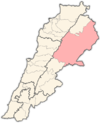Brital
بريتال | |
|---|---|
Village | |
| Coordinates: 33°56′7″N 36°9′3″E / 33.93528°N 36.15083°E | |
| Country | |
| Governorate | Baalbek-Hermel Governorate |
| District | Baalbek District |
| Elevation | 3,770 ft (1,150 m) |
| Time zone | UTC+2 (EET) |
| • Summer (DST) | +3 |
Brital (Arabic: بريتال) is a village located in the Baalbek District of the Baalbek-Hermel Governorate in Lebanon.
YouTube Encyclopedic
-
1/2Views:2 1084 844
-
Brital, Lebanon HD
-
BRITAL DAY3A
Transcription
History
In 1838, Eli Smith noted Brital (under the name of Bereitan) as a Metawileh village in the Baalbek area.[1]
Brital has been a well-known town for its rebellious people in the times before and after the creation of Lebanon in 1924. Due to the town's mountainous landscape, multiple revolutions against any occupation were born in Brital. The revolution against the French mandate was led by a prominent Britali and his local men (Melhem Kassem al-Masri), also Brital is the birthplace of the Amal movement and Hezbollah.[citation needed]
Brital is the home village of Sheikh Subhi Tufayli one of the early leaders of Hizbollah who was later expelled from the group and set up his own organisation, “the Hunger Revolution”.[2]
Brital's municipal land boundaries span over vast areas of the anti-Lebanon mountains, east to Syria, south to Anjar and to Arsal in the north. Its population is made of a number of large families: Azki, Mazloum, Ismail, Saleh, Tlais, Jaafar, Masri, Affi, Ahmar, Youness and Ghadban are the main ones.[citation needed]
References
Bibliography
External links
- Brital, localiban


